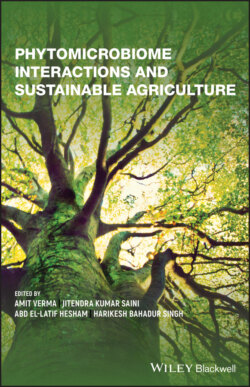Читать книгу Phytomicrobiome Interactions and Sustainable Agriculture - Группа авторов - Страница 33
3.3 Metagenomics of Plant Rhizosphere
ОглавлениеThe rhizosphere, a narrow zone of soil, is generally altered by factors like plant root secretions. It is rich in the microbiome population and may carry up to 108–1012 bacterial cells per gram of root or rhizosphere soil (Kennedy and de Luna 2005; Egamberdieva et al. 2008) that comprises more than 30 000 prokaryotic species (Suyal et al. 2016). These rhizospheric microbes have tremendous diversity in terms of their metabolic capabilities, thus playing a vital role in plant health. Therefore, to unveil their roles in the plant system, a proper understanding of their community structure is the need of the hour. Traditionally, genomics has focused on the small proportion, i.e. 1–3% of cultivable microbes; however, due to the advancement in culture‐independent molecular tools like metagenomics, high‐throughput DNA sequencing, and bioinformatics, our understanding of microbial activities in the rhizosphere has been revolutionized. With the help of advanced DNA—sequencing technologies, the microbial community structures in the rhizosphere can be characterized and compared with the microbial structures in distant soil, a part of the soil that does not come under the direct influence of the root (Turner et al. 2013; Bouffaud et al. 2014; Ofek‐Lalzar et al. 2014; Roume et al. 2015). Using a high‐throughput sequencing‐based metagenomic approach, the composition and function of the microbial community in influent water (as a reference matrix) and reed rhizosphere soil of a constructed wetland has been explored (Bai et al. 2014). Recently, microbiome functions in the rhizospheric region were analyzed utilizing a similar approach, in which a metabolic‐network–based framework for metagenomics was used (Ofaim et al. 2017). To investigate the microbial diversity in a rhizospheric region of paddy fields, advanced molecular biology tools can be applied. It includes culture‐independent molecular techniques, 16S rRNA clone library generation along with RFLP, sequencing, and phylogenetic analysis, etc. (Arjun and Harikrishnan 2011). Furthermore, metagenomic analysis of rhizosphere of plants adapted to acid mine drainage revealed the presence of novel nickel resistance genes (Mirete et al. 2007). These approaches reveal that the soil and rhizosphere microbiomes diversity is highly underrated (Mendes et al. 2013).
Figure 3.1 Metagenomic approach to reveal the structure and function of a plant microbiome.
(Source: Sleator et al. (2008) © 2008, Society for Applied Microbiology. Reprinted with permissions of John Wiley & Sons).
Table 3.1 Advance molecular techniques used for the characterization of various rhizospheric microbial communities.
| Techniques used | Rhizosphere | References |
|---|---|---|
| Amplicon gene sequencing of conserved marker genes,16S rRNA | Barley and alfalfa | Kumar et al. (2018b) |
| Rice roots | Edwards et al. (2018) | |
| Metagenome sequencing | Taxus rhizosphere | Hao et al. (2018) |
| Wheat and cucumber | Ofaim et al. (2017) | |
| Metatranscriptome sequencing | Wheat | Hayden et al. (2018) |
| Seagrass Microbiomes | Crump et al. (2018) | |
| Metaproteomic profiling | Biscutella laevigata | Mattarozzi et al. (2017) |
| Sugarcane | Lin et al. (2013) | |
| Metabolomic profiling | Arabidopsis | Pétriacq et al. (2017) |
However, metagenomic prediction by quantifying the 16S rRNA gene has revealed an abundance of bacteria in the rhizosphere (Lopes et al. 2016). Bacterial diversity associated with the rhizosphere of wheat plants (Triticum aestivum) was also explored using metagenomic analysis. It revealed the presence of a highly diverse class of bacteria in the wheat rhizosphere, which includes Actinobacteria, Bacilli, Clostridia, Alphaproteobacteria, Betaproteobacteria, Deltaproteobacteria, Gammaproteobacteria, and few uncultivable bacteria (Velázquez‐Sepúlveda et al. 2012). Some of the recent metagenomics techniques used to reveal various rhizospheres are listed in Table 3.1.
